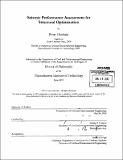| dc.contributor.advisor | Jerome J. Connor. | en_US |
| dc.contributor.author | Ghisbain, Pierre | en_US |
| dc.contributor.other | Massachusetts Institute of Technology. Department of Civil and Environmental Engineering. | en_US |
| dc.date.accessioned | 2013-12-06T20:47:24Z | |
| dc.date.available | 2013-12-06T20:47:24Z | |
| dc.date.issued | 2013 | en_US |
| dc.identifier.uri | http://hdl.handle.net/1721.1/82833 | |
| dc.description | Thesis (Ph. D.)--Massachusetts Institute of Technology, Department of Civil and Environmental Engineering, 2013. | en_US |
| dc.description | Cataloged from PDF version of thesis. | en_US |
| dc.description | Includes bibliographical references (pages 223-228). | en_US |
| dc.description.abstract | The economic impact of earthquakes has spurred the implementation of performance-based design to mitigate damage in addition to protecting human lives. A developing trend is to consider damage directly as a measure of seismic performance. In spite of the ability to estimate the cost of future earthquakes, adjusting the investment in seismic upgrades is impeded by the computational requirements of the probabilistic damage assessment. In this dissertation, we develop the damage assessment tools needed to implement structural optimization with an estimate of lifetime seismic damage in the objective function. A parametric study of the procedure to predict damage from earthquake simulation results is presented. By varying the procedure and analyzing the effects on the damage estimate, we identify simplifications that are beneficial for practical applications without losing important information about the behavior of the structure under seismic loads. The runtime of the probabilistic damage assessment is dominated by the response analysis of the structure to a range of earthquake scenarios. We consider alternatives to the standard but expensive nonlinear dynamic analysis, and we evaluate the error introduced by the faster analysis methods. The applicability of linear dynamic analysis is further investigated by detailing the effects of structural nonlinearities on the lifetime damage assessment. We determine that these effects are limited for the performance-based designed buildings, whose responses to the moderate but more frequent earthquakes remain essentially elastic. An application to the placement and sizing of viscous dampers in building frames is presented. A first procedure seeks the optimal trade-off between the investment in damping and the losses due to future earthquakes. For each level of damping considered, another optimization problem is solved to determine the most efficient damper layout considering the results of the damage assessment in a true performance-based design process. | en_US |
| dc.description.statementofresponsibility | by Pierre Ghisbain. | en_US |
| dc.format.extent | 228 pages | en_US |
| dc.language.iso | eng | en_US |
| dc.publisher | Massachusetts Institute of Technology | en_US |
| dc.rights | M.I.T. theses are protected by
copyright. They may be viewed from this source for any purpose, but
reproduction or distribution in any format is prohibited without written
permission. See provided URL for inquiries about permission. | en_US |
| dc.rights.uri | http://dspace.mit.edu/handle/1721.1/7582 | en_US |
| dc.subject | Civil and Environmental Engineering. | en_US |
| dc.title | Seismic performance assessment for structural optimization | en_US |
| dc.type | Thesis | en_US |
| dc.description.degree | Ph.D. | en_US |
| dc.contributor.department | Massachusetts Institute of Technology. Department of Civil and Environmental Engineering | |
| dc.identifier.oclc | 863157408 | en_US |
